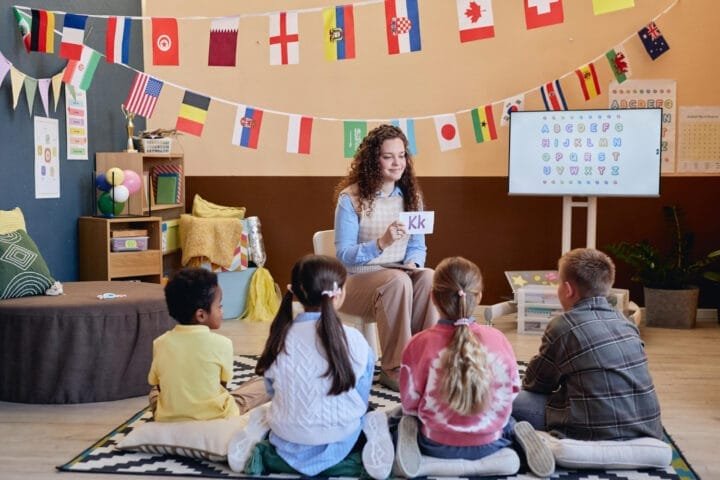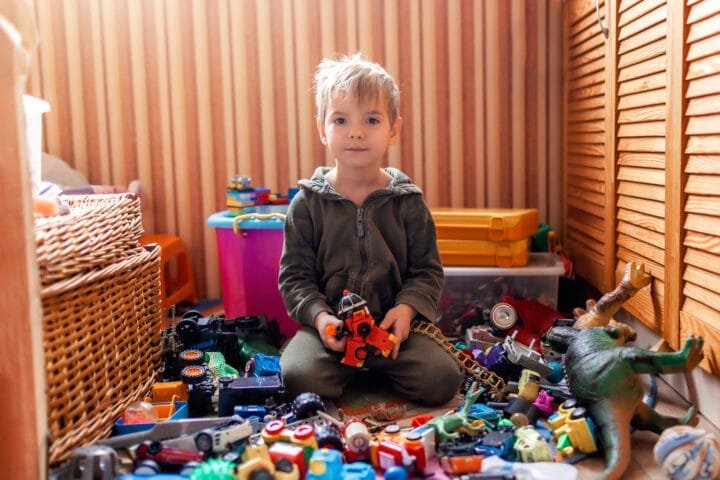Are You Harming Your Child? The Truth About Screen Time Limits Every Parent Needs to Know
I was sitting in a café yesterday, sipping my latte, when I noticed a family of five at the next table. Three children, all under 10, each glued to their own device. No conversation. No interaction. No laughter. Just the glow of screens illuminating their little faces. As a child development specialist who’s worked with hundreds of families, I couldn’t help wondering: are we unknowingly harming our children with all this screen time?
Did you know that half of American children now have their own smartphone by age 11? These kids spend an average of 4.5 hours daily just on their phones. When you factor in all devices, children today spend between 7-10 hours daily staring at screens. Even more alarming, 68% of children under 13 have already used social media apps like TikTok and Snapchat.
In today’s digital world, the question isn’t whether to limit your child’s screen time, it’s how to do it effectively. Let’s explore this challenging parenting territory together, examining what research actually tells us about screen time effects and the most effective approaches to creating healthy digital boundaries.
The Digital Reality We’re Facing
Remember when “screen time” meant Saturday morning cartoons? Those days are long gone. Today’s children are digital natives, born into a world where screens are everywhere—from smartphones to tablets, laptops to smart TVs. The average American household has 25 connected devices. Twenty-five!
Sarah, a mother of three from Boston who attended one of my workshops, confessed, “I feel like I’m fighting a losing battle. My 8-year-old throws a complete tantrum if I take away his iPad, and my teenager acts like I’ve cut off oxygen when I limit her phone time.”
Sound familiar? You’re not alone.
Recent surveys show that 71% of parents are concerned about their children’s screen time, yet 69% feel unsure about how to manage it effectively. We’re navigating uncharted waters without a reliable map.
The pandemic only intensified our screen dependence. Remote learning and social distancing pushed children further into digital worlds, with screen time increasing by 50-60% during lockdowns. For many families, those elevated levels never fully returned to pre-pandemic norms.
What Science Actually Says About Screen Time
The relationship between screen time and child development isn’t as straightforward as headlines might have you believe. Let’s break down what research actually tells us.
The American Academy of Pediatrics once recommended strict time limits: no screen time for children under 2 and no more than 2 hours daily for older children. Their position has evolved significantly. Why? Because research revealed that not all screen time is created equal.
A groundbreaking 2019 study published in JAMA Pediatrics examined over 2,400 children and found that the content children consume matters more than the time spent consuming it. Educational programming positively impacted language development, while passive entertainment showed negative effects regardless of duration.
Dr. Michelle Carter, pediatric neurologist at Stanford Children’s Health, explains: “The developing brain responds differently to different types of digital engagement. Interactive educational content that requires problem-solving activates different neural pathways than passive scrolling through social media feeds.”
This content-focused approach represents a fundamental shift in how experts view digital media’s impact on children. The Oxford Internet Institute’s 2021 research involving over 12,000 adolescents found “no measurable link between the amount of time spent using digital technology and adolescent well-being.”
That doesn’t mean unlimited screens are fine. The evidence for some negative impacts remains compelling:
- Blue light exposure before bedtime disrupts melatonin production, affecting sleep quality
- Extended sedentary screen time correlates with increased obesity rates
- Excessive social media use links to higher rates of anxiety and depression in teens
- Reduced face-to-face interaction can impact social skill development
The nuance here matters tremendously. The research doesn’t support demonizing all screen time, nor does it suggest a digital free-for-all.
Time-Based vs. Content-Based Approaches
Traditional screen time management focuses almost exclusively on hours and minutes—the quantitative approach. But growing evidence suggests a qualitative approach might be more effective.
The Traditional Time-Based Approach
The time-based method operates on a simple premise: limit hours of screen exposure. Examples include:
- No screens during meals
- Screen-free hour before bedtime
- Maximum daily limits (often 1-2 hours for entertainment)
- Screen-free days or “digital sabbaths”
This approach offers clear advantages. It’s straightforward to implement and monitor. You can use parental controls to enforce time limits automatically. It also helps prevent the displacement of essential activities like physical play, reading, and face-to-face social interaction.
Jessica, a mother from Chicago, shared her experience: “Setting a timer worked wonders with my 6-year-old. When it goes off, he knows screen time is overnight. The clear boundary eliminated daily battles.”
However, time limits come with significant drawbacks. They treat all screen activities as equally valuable (or harmful). Watching educational content counts the same as mindless videos. They also don’t teach children to self-regulate their digital consumption crucial skills for their future.
The Content-Based Alternative
Content-based management focuses less on how long and more on what children are consuming. This approach:
- Evaluate apps, games, and programs based on educational value
- Emphasizes interactive over passive consumption
- Considers age-appropriateness and developmental benefits
- Encourages co-viewing and discussion
Dr. James Porter, digital wellness expert, notes: “Content-based approaches acknowledge that thirty minutes of creative digital art has fundamentally different developmental impacts than thirty minutes of violent gaming or passive YouTube consumption.”
My work with families has shown that content-focused strategies often lead to more thoughtful digital citizens. Children learn to ask themselves: “Is this worth my time?” rather than simply watching until their allotted time expires.
This approach requires more parental involvement and ongoing conversation about digital choices. It’s not about abandoning time considerations entirely but making content quality the primary factor.
Finding Your Family’s Balance: A Hybrid Approach
After observing hundreds of families navigate these challenges, I’ve found that most successful strategies combine elements of both approaches. Here’s how you might create a balanced framework:
- Establish basic time boundaries that protect essential activities
- Within those boundaries, prioritize high-quality, age-appropriate content
- Adjust based on your child’s unique needs and responses
- Involving children in the process as they mature
Let me share how this worked for the Martinez family, who participated in our digital wellness program. They established “tech-free zones” (bedrooms and dining areas) and times (mornings before school and one hour before bed). Within their children’s allowed screen time, they created a tiered system: educational apps had higher time allowances than entertainment. As their children demonstrated responsible choices, they earned more autonomy.
Within six weeks, their 12-year-old daughter started voluntarily limiting her social media use, noting she felt “happier” when she spent less time comparing herself to others online. Their 8-year-old son became more selective about games, choosing those with creative elements over passive experiences.
The key was consistency coupled with flexibility and ongoing conversation rather than rigid rules.
Age-Specific Guidelines That Actually Work
Children’s developmental needs change dramatically as they grow. Screen management strategies should evolve accordingly.
Babies and Toddlers (0-2 years)
The science here is clear: babies and toddlers learn primarily through three-dimensional interactions with people and objects. Research from Boston University shows that toddlers struggle to transfer knowledge from 2D screens to 3D reality—what researchers call the “video deficit.”
For this age group, prioritize:
- Face-to-face interaction
- Physical play and exploration
- Limited or no independent screen time
- If screens are used, choose video chatting with relatives or co-viewing quality content
Emma, mother to 18-month-old Jacob, shared: “I was religious about no screens until I had the flu and was desperate. I discovered that sitting with Jacob while watching short, slow-paced educational videos and talking about what we saw became special bonding time when used sparingly.”
Preschoolers (3-5 years)
At this age, children begin developing the cognitive ability to learn from quality digital content, though real-world experiences remain superior.
Effective approaches include:
- Limiting entertainment screen time to 1 hour daily
- Choosing interactive educational content over passive viewing
- Using screens together whenever possible
- Creating clear before/after routines to ease transitions
Research from Northwestern University found that parental co-viewing increases learning from educational content by 23% for preschoolers. When parents ask questions and relate screen content to real-world experiences, the benefits multiply.
Elementary Age (6-10 years)
This age represents a transition period where children begin using digital tools for school while still needing significant guidance.
Consider:
- Distinguishing between educational and entertainment screen time
- Establishing tech-free zones and times
- Teaching basic digital literacy and safety
- Introducing the concept of balance
An interesting 2022 study from Children’s Hospital of Philadelphia found that elementary children whose parents explained the reasoning behind screen limits were 45% more likely to demonstrate self-regulation with devices than those given arbitrary rules.
Tweens and Teens (11-17 years)
Adolescents need increasing autonomy while still benefiting from structure. Their developing brains are particularly vulnerable to addictive design elements in apps and games.
Focus on:
- Collaborative rather than dictated boundaries
- Open conversations about digital citizenship
- Privacy and safety education
- Modeling healthy tech habits yourself
Dr. Lisa Damour, an adolescent psychologist, explains: “Teenagers need practice managing their own screen time before leaving for college. A gradual release of responsibility, with ongoing conversation and occasional check-ins, prepares them better than strict external controls that suddenly disappear.”
This gradual shift toward self-regulation is crucial. Research shows that teens whose parents maintain extremely rigid control often binge on screens when they finally gain independence.
Warning Signs Your Child’s Screen Use Is Problematic
Not all excessive screen use looks the same. Here are evidence-based indicators that your child’s digital habits may need intervention:
- Sleep disruption or difficulty falling asleep
- Declining grades or incomplete homework
- Decreased interest in non-screen activities they previously enjoyed
- Irritability, anger, or emotional volatility when screen time ends
- Withdrawal from face-to-face social interactions
- Physical complaints (headaches, eye strain, wrist pain)
- Secretive behavior about device use
These warning signs don’t necessarily mean addiction but do warrant attention and possible adjustment to your approach.
Michael, father to 14-year-old Tyler, recognized several warning signs: “Tyler was sleeping poorly, grades slipping, and he’d become irritable during family outings, constantly checking his phone. What worked wasn’t confiscating the phone—that created massive conflict—but working with a family therapist who helped us establish a contract with clear expectations and consequences.”
The Power of Modeling Healthy Digital Habits
Children learn more from what we do than what we say. Research from Common Sense Media found that 51% of teens report seeing their parents regularly distracted by phones during conversations.
When I ask children in my workshops who they think uses screens too much, they frequently point to their parents. One 9-year-old memorably told me, “My mom says I watch too much YouTube, but she’s on her phone ALL the time.”
The research backs this observation. A 2020 study in JAMA Pediatrics found that parents who reported the highest personal screen use were three times more likely to have children with problematic digital habits.
Consider implementing these family-wide practices:
- Device-free meals without exceptions
- Charging all family devices outside bedrooms overnight
- Screen-free family activities each week
- “Tech timeouts” where everyone unplugs simultaneously
Rachel, a marketing executive and mother of two, created “Phone-Free Fridays” for her family: “The first few weeks were rough—I realized how automatically I reached for my phone. But now our Fridays include board games, cooking together, and actual conversations. My kids stopped complaining once they saw I was serious about following the rules myself.”
Creating a Sustainable Family Media Plan
Rather than reactive restrictions, consider developing a proactive family media plan. This structured approach creates clarity and buy-in from all family members.
A comprehensive plan typically addresses:
- When screens are and aren’t appropriate
- Where devices can and cannot be used
- What types of content are encouraged vs. discouraged
- How screen time integrates with other priorities
- Special considerations for school nights vs. weekends
- Consequences for boundary violations
The American Academy of Pediatrics offers a free online tool for creating customized family media plans, adaptable to your family’s specific values and needs.
The most successful plans evolve over time. Schedule quarterly “digital check-ins” to assess what’s working and what needs adjustment. Include children in these conversations, especially as they mature.
The Wilson family created a visual media plan that hangs on their refrigerator. Ten-year-old Mia told me proudly, “I helped make our screen rules, so I feel responsible for following them. And I get to remind my dad when he breaks them too!”
Beyond Limits: Teaching Digital Literacy
Restrictions alone won’t prepare children for a digital future. Alongside boundaries, focus on developing these critical skills:
- Information evaluation: How to identify credible sources
- Privacy awareness: Understanding digital footprints
- Critical consumption: Recognizing advertising, bias, and manipulation
- Creative production: Using technology as a tool for creation
- Ethical participation: Responsible online citizenship
Dr. Devorah Heitner, author of “Screenwise,” emphasizes: “Our goal shouldn’t just be less screen time, but better screen time. We want to raise thoughtful digital citizens who use technology intentionally rather than compulsively.”
This education starts earlier than many parents realize. Even young children can understand simple concepts like “not everything online is true” or “we ask before posting pictures of others.”
When Screens Become Escape Routes: Addressing Underlying Issues
Sometimes excessive screens use signals for other challenges. Children might retreat into digital worlds to escape:
- Academic struggles
- Social difficulties
- Family conflict
- Anxiety or depression
- Lack of engaging alternatives
Sixteen-year-old Jordan spent hours gaming daily. His parents tried restricting screen time without success. During family therapy, Jordan revealed feeling overwhelmed by academic pressure and social anxiety. The screens weren’t the primary problem, they were his coping mechanism. Once the underlying issues were addressed, his screen was naturally moderated.
If restrictions lead to extreme emotional reactions or seem ineffective despite consistency, consider consulting a mental health professional who specializes in children and adolescents.
The Unexpected Benefits of Strategic Screen Limits
When implemented thoughtfully, reasonable boundaries around technology often yield surprising benefits beyond what parents initially expect.
Families in our digital wellness programs consistently report:
- Improved sleep quality and duration
- Enhanced family communication
- Increased physical activity
- Greater creativity and imaginative play
- Reduced household conflict
- Higher academic performance
- Improved attention spans
One unexpected outcome many parents note is their children’s increased tolerance for boredom, that productive mental state where creativity often emerges. In our overstimulated world, the ability to sit with momentary boredom rather than immediately reaching for digital distraction represents a valuable skill.
The Path Forward: Balance Not Perfection
If there’s one message, I hope you’ll take from this exploration, it’s that balance matters more than perfection. The goal isn’t eliminating screens; they’re an integral part of modern life. The goal is intentional use aligned with your family’s values.
The most successful families I’ve worked with don’t aim for rigid control but for thoughtful integration of technology into a well-rounded life. They recognize that occasional exceptions for movie nights, long car trips, or parental sanity maintenance don’t derail their overall approach.
Remember that children are remarkably resilient. If your current approach isn’t working, you can adjust to the course. Each family must find their unique balance based on their children’s temperaments, developmental stages, and family circumstances.
As you navigate these complex waters, be gentle with yourself. Perfect digital parenting doesn’t exist. What matters is thoughtful engagement with these issues and a willingness to learn and adapt together with your children.
What screen time approach has worked best for your family? What challenges are you still facing? The conversation about raising healthy children in a digital world continues to evolve, and your experiences contribute valuable insights to this important dialogue.
FAQs
Guidelines by age group:
- Under 18 months: No screen time at all except for video chatting with loved ones
- 18 months to 6 years: Limit screen use to less than one hour per day with high-quality content and adult supervision
- 7-12 years: Limit screen use to less than two hours per day (excluding schoolwork)
- Over 12: No specific time limits, but ensure screen time doesn’t interfere with sleep, physical activity, learning, and quality time with friends and family
The American Academy of Pediatrics updated their recommendations in 2016, emphasizing balance rather than setting rigid hour-based limits.
Excessive screen time can cause several issues:
- Sleep disturbance and behavioral problems
- Reduced physical activity leading to increased obesity
- Attention problems
- Lower self-esteem
- Higher levels of emotional distress
- Social development issues
- Vision problems from extended screen viewing
Research shows children from lower-income households spend nearly twice as much time on screens compared to those from higher-income families.
To establish effective limits, try these strategies:
- Create a family media plan where parents also model the desired behavior
- Designate screen-free times (during meals, driving) and screen-free zones (bedrooms)
- Ensure children get appropriate sleep and the recommended one hour of daily physical exercise
- Use parental controls but be aware that determined children may find workarounds
- Have regular conversations about online behavior and appropriate screen use
- Consider screen time as a privilege to be earned through completing homework, chores, etc.
High-quality content is crucial:
- For toddlers 2-5 years, well-designed educational programs like Sesame Street can improve literacy and numeracy
- View media together with children where possible; actively engage them by discussing what they’re viewing
- Choose educational content that’s age-appropriate and check content ratings when available
- Avoid passive screen use and balance with interactive, educational content
- For children 7-12 years, parents should monitor online activities and use parental controls to ensure appropriate content
- Children under 13 should not have access to social media services
To balance screen time:
- Develop a screen use plan or timetable
- Ensure no screens during meals and one hour before bedtime
- Model the behavior you want to see – if your phone must be away at mealtimes, so should yours
- Create a family charging station to remove devices from bedrooms at night
- Replace idle scrolling with activities you’d like your child to copy (reading, exercising, etc.)
- Consider occasional screen-free days or weeks, especially during school holidays
- Prioritize face-to-face interaction, outdoor play, and physical activities
Top 5 Books About Screen Time Limits for Children
This entertaining book targets elementary-age children with access to devices. It encourages thoughtful conversation about screen limits and tech-life balance through a fun dragon character. Perfect for helping kids make connections to their own lives and develop screen time solutions.
Part of the popular Ninja Life Hacks series, this book helps kids recognize their emotions related to screen time and the behaviors that excessive screen use can trigger. While focused on phone usage, parents can easily adapt the lessons for TV or tablet use.
This research-based book explores the unique characteristics of the generation born between 1995-2012 who grew up with smartphones and social media as integral parts of their lives. Dr. Twenge examines the complex relationship between mental health and technology, offering insights into supporting today’s youth.
Digital parenting expert Heitner provides practical advice for setting boundaries, modeling responsible screen use, and fostering open communication about online experiences. Her approach of “mentorship over monitoring” emphasizes being a positive role model rather than just policing digital activity.
This book teaches parents how to help children use technology as a tool to enhance their lives rather than letting it control them. Graber provides strategies for developing crucial skills like empathy, critical thinking, and digital citizenship, preparing kids to navigate the digital landscape responsibly.















































































